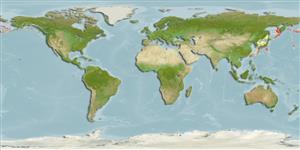>
Perciformes/Cottoidei (Sculpins) >
Liparidae (Snailfishes)
Etymology: Careproctus: Greek, kara = face + Greek, proktos = anus (Ref. 45335); lycopersicus: Named for the tomato plant, Solanum lycopersicum, meaning ‘wolf peach'; referring to its typically bright red tomato-like coloration..
Environment: milieu / climate zone / depth range / distribution range
Ecologia
marino batidemersale; distribuzione batimetrica 397 - 1157 m (Ref. 91047). Temperate
North Pacific: Bering Sea and the eastern Aleutian Islands.
Size / Peso / Age
Maturity: Lm ? range ? - ? cm
Max length : 13.3 cm TL maschio/sesso non determinato; (Ref. 91047); 17.2 cm TL (female)
Short description
Morfologia | Morfometria
Raggi dorsali molli (totale): 42-45; Raggi anali molli: 34 - 38; Vertebre: 45 - 50. This species is distinguished from its congeners by the following characters: premaxilla and dentary with broad rows of strongly trilobed teeth (vs. simple or weakly trilobed teeth on both jaws); the large gill opening extends ventrally to pectoral rays 8-12 (vs. smaller above the pectoral fin or extending to less than five pectoral-fin rays); large pelvic disk greater or equal 30% head length (vs. smaller pelvic disk, < 25% HL); most similar to C. ovigerus, which can be distinguished from C. lycopersicus by its simple, canine teeth on both jaws, and to C. kamikawai, which is distinguished by its subterminal mouth, slight dorsal-fin lobe, black peritoneum, smaller pelvic disc, slender caudal base, and more anterior position of the pelvic disc, anus, and anal-fin origin (Ref. 91047).
One 11.6 cm TL ripe male and female specimens were examined: the smallest female with yolked eggs was 14.9 cm (UW 119817). For the ripe females, at least two sizes of eggs were present, yolked eggs were 3.5 mm in diameter and smaller white eggs had diameters of 0.5-1.5 mm (Ref. 91047).
Life cycle and mating behavior
Maturità | Riproduzione | Deposizione | Uova | Fecundity | Larve
Orr, J.W., 2012. Two new species of snailfishes of the genus Careproctus (Scorpaeniformes: Liparidae) from the Bering Sea and Eastern North Pacific Ocean, with a redescription of Careproctus ovigerus. Copeia 2012(2):257-265. (Ref. 91047)
IUCN Red List Status (Ref. 130435)
Threat to humans
Harmless
Human uses
Informazioni ulteriori
Nomi ComuniSinonimiMetabolismoPredatoriEcotossicologiaRiproduzioneMaturitàDeposizioneSpawning aggregationFecundityUovaEgg development
Age/SizeAccrescimentoLength-weightLength-lengthLength-frequenciesMorfometriaMorfologiaLarveDinamica popolazioni larvaliReclutamentoAbbondanzaBRUVS
BibliografiaAcquacolturaProfilo di acquacolturaVarietàGeneticaElectrophoresesEreditarietàMalattieElaborazioneNutrientsMass conversion
CollaboratoriImmaginiStamps, Coins Misc.SuoniCiguateraVelocitàModalità di nuotoArea branchialeOtolithsCervelliVista
Strumenti
Special reports
Download XML
Fonti Internet
Estimates based on models
Preferred temperature (Ref.
123201): 2 - 3.5, mean 3.3 °C (based on 22 cells).
Phylogenetic diversity index (Ref.
82804): PD
50 = 0.5000 [Uniqueness, from 0.5 = low to 2.0 = high].
Bayesian length-weight: a=0.00447 (0.00204 - 0.00980), b=3.17 (2.99 - 3.35), in cm total length, based on LWR estimates for this Genus-body shape (Ref.
93245).
Trophic level (Ref.
69278): 3.2 ±0.5 se; based on size and trophs of closest relatives
Resilienza (Ref.
120179): Alto, tempo minimo di raddoppiamento della popolazione meno di 15 mesi (Preliminary K or Fecundity.).
Fishing Vulnerability (Ref.
59153): Low vulnerability (10 of 100).
